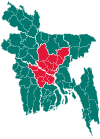Baksiganj Upazila: Difference between revisions
| Line 105: | Line 105: | ||
Baksiganj thana was turned into an upazila in '''1982'''. The upazila consists of 7 union parishads, 25 mouzas and 196 villages |
Baksiganj thana was turned into an upazila in '''1982'''. The upazila consists of 7 union parishads, 25 mouzas and 196 villages |
||
Baksijang thana has a remarkable development through out the years. The key developer of this thana |
Baksijang thana has a remarkable development through out the years. The key developer of this thana are Shamsul Haque Siddique & Babul Chisty. During 2005 Mr.Babul Chisty set up Agricultural industries in the heart of Baksiganj thana, he set up the first Filling station. Mr. Babul Chisty is the key developer of modern baksiganj. |
||
==See also== |
==See also== |
||
*[[Upazilas of Bangladesh]] |
*[[Upazilas of Bangladesh]] |
||
Revision as of 16:57, 14 October 2009
Baksiganj
বকশিগঞ্জ | |
|---|---|
| Country | |
| Division | Dhaka Division |
| District | Jamalpur District |
| Area | |
| • Total | 204.3 km2 (78.9 sq mi) |
| Population (1991) | |
| • Total | 157,403 |
| • Density | 770/km2 (2,000/sq mi) |
| Time zone | UTC+6 (BST) |
| Postal code | 2140 |
| Website | Official Map of Baksiganj |
Baksiganj (Template:Lang-bn) is an Upazila of Jamalpur District in the Division of Dhaka, Bangladesh.
History
Baksiganj is located at 25°13′30″N 89°52′30″E / 25.2250°N 89.8750°E . It has 32007 units of house hold and total area 204.3 km².
Administration Baksiganj thana was turned into an upazila in 1982. The upazila consists of 7 union parishads, 25 mouzas and 196 villages.In Bakshigonj have some Haat Bazer. Noim Mia Bazer it open on Saturday and Wednesday.
Baksiganj (Town) The area of the Baksiganj town is 3.86 km². It has a population of 8573; male 50.97%, female 49.03%; population density is 2220 per km². Literacy rate among the town people is 25.9%.
Historical events During the war of liberation the Pakistan army established a military camp at Kamalpur, in the northern sector. From the point of view of war strategy this camp was so important that its fall meant to lose control over the whole Jamalpur-Dhaka region. The freedom fighters attacked Kamalpur many times. On 31 July 1971 the freedom fighters attacked Kamalpur under the command of Major Moinul Hussain Chowdhury, Battalion Commanding Officer of the 1st East Bengal Regiment of Sector 11. This time final victory was not achieved but the casualty in the Pakistan army was huge. In this battle 35 freedom fighters including Captain Salahuddin Momtaz, Ahaduzzaman and Abul Kalam Azad were killed. On 14 November 1971 Abu Taher lost one of his legs by explosive.
Marks of War of Liberation Mass grave 7, Playground of Baksiganj High School, Kamalpur Health Centre, Kamalpur Bazar, Battajor, Dhanua Baksiganj Cattle Hat, Bakshigonj Bazar.
Data
Population 157403; male 50.80%, female 49.20%; Muslim 98.08%, Hindu 1.25%, Christian 0.44%, and others 0.22%.
Religious institutions Mosque 287, temple 1.
Literacy and educational institutions Average literacy 17.4%; male 22.8%, female 11.8%. Educational institutions- college 3(One is Bakshigonj Govt K.U. College, Khatamun Moin Girls College[near of Sorker Bari] and Niloxkhia College), secondary school 13,Bakshigonj N.M high shool (near Miah Bari), madrasa 46, government primary school 49, non-government primary school 60.
Cultural organisations Rural club 27, cinema hall 2, literary society 6, women's organisation 1, play ground 22.
Main occupations Agriculture 40.46%, fishing 1.28%, agricultural labourer 26.24%, wage labourer 2.95%, commerce 12.92%, service 3.08% and others 13.07%.
Land use Total cultivable land 14885.88 hectares, fallow land 2747.88 hectares; single crop 9.36%, double crop 56.22% and treble crop land 34.42%.
Land control Among the peasants 21.21% are landless, 30.07% marginal, 31.12% small, 14.52% intermediate and 3.08% rich.
Value of land The market value of the land of the first grade is 7500 Taka per 0.01 hectare(depend on Area).
Main crops Paddy, jute, sugar cane, mustard seed, wheat, sweet potato, turmeric, onion, garlic, cabbage, cauliflower, brinjal, pulse and vegetables.
Extinct or nearly extinct crops Linseed, sesame, kaun, corn and peanut.
Main fruits Banana, black berry, papaya, pine apple and water melon.
Fisheries, dairies, poultries Cattle breeding centre 2, poultry farm 16, hatchery 3.
Communication facilities Roads: pucca road 36 km, semi pucca 19 km, mud road 106 km.
Traditional transport Palanquin, horse carriage and bullock cart. These means of transport are either extinct or nearly extinct.
Cottage industries Loom 1700, handicrafts 36, blacksmiths 98, potteries 9, bamboo and cane works 355, wood workers 132, jute and cotton works 16.
Hats, bazars and fairs Hats and bazars are 5, most noted hat is Nayem Mia Hat.
Main exports Jute, paddy, cotton, mustard seed, onion, garlic and turmeric.
NGO activities Operationally important NGOs are brac, asa, grameen bank, CARE, Unnayan Sangha and Jibika.
Health centres Upazila health complex 1, family planning centre 7, satellite clinic 3. [info@Hasan Md. Rabiul Islam]
Demographics
As of the 1991 Bangladesh census, Baksiganj has a population of 157403. Males constitute are 50.8% of the population, and females 49.2%. This Upazila's eighteen up population is 76635. Baksiganj has an average literacy rate of 17.4% (7+ years), and the national average of 32.4% literate.[1]
Administrative
Baksiganj thana was turned into an upazila in 1982. The upazila consists of 7 union parishads, 25 mouzas and 196 villages Baksijang thana has a remarkable development through out the years. The key developer of this thana are Shamsul Haque Siddique & Babul Chisty. During 2005 Mr.Babul Chisty set up Agricultural industries in the heart of Baksiganj thana, he set up the first Filling station. Mr. Babul Chisty is the key developer of modern baksiganj.
See also
References
- ^ "Population Census Wing, BBS". Archived from the original on 2005-03-27. Retrieved November 10 2006.
{{cite web}}: Check date values in:|accessdate=(help); Unknown parameter|dateformat=ignored (help)

